
Arthington is a linear village in Wharfedale, in the City of Leeds metropolitan borough in West Yorkshire, England. It is a civil parish which, according to the 2011 census, had a population of 532. It is in the Otley ward of the City of Leeds, and the Leeds North West parliamentary constituency.

Cookridge is a suburb of north-west Leeds, West Yorkshire, England, north of the Leeds Outer Ring Road. In 1715 Ralph Thoresby described it as a village four miles from Leeds and three from Otley, dating from 1540.

Bramhope is a village and civil parish in the City of Leeds metropolitan borough, West Yorkshire, England, north of Holt Park and north east of Cookridge.

The Leeds Corn Exchange is a shopping mall in Leeds, West Yorkshire, England. The structure, which was commissioned as a corn exchange, is a grade I listed building.

Cuthbert Brodrick FRIBA was a British architect, whose most famous building is Leeds Town Hall.

The Grand Theatre, also known as Leeds Grand Theatre and Leeds Grand Theatre and Opera House, is a theatre and opera house in Briggate, Leeds, West Yorkshire, England. It seats approximately 1,500 people.
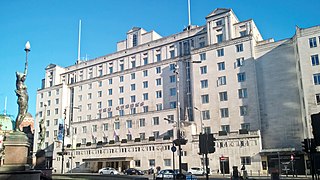
The Queens Hotel is a large hotel located on City Square in Leeds, West Yorkshire, England. Built in 1937, it is an elegant Art Deco Grade II listed building and was frequented by the likes of Princess Grace of Monaco, Cary Grant and Nelson Mandela throughout its history.
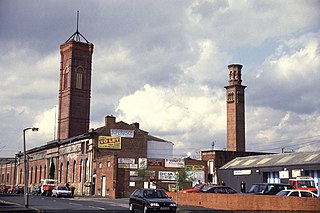
Tower Works is a former factory notable for its three listed towers. It is located on Globe Road in Holbeck, Leeds, West Yorkshire, next to the Leeds and Liverpool Canal. The Italianate towers of the factory are a distinctive landmark on the Leeds skyline.
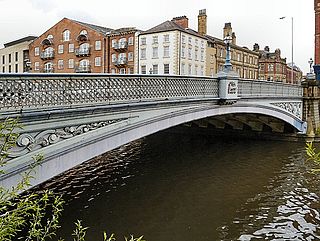
Leeds Bridge is a historic river crossing in Leeds, England. The present cast iron road bridge over the River Aire dates from 1870. It is Grade II listed.

The Light is a leisure and retail centre in central Leeds in West Yorkshire, England. It occupies the rectangular space between The Headrow on the south, St Anne's Street on the north, Cookridge Street on the west, and Albion Street. Two former streets divide it: Upper Fountaine Street (east-west) and Cross Fountaine Street (north-south) now covered with a glass roof. It incorporates two listed buildings Permanent House and the Headrow Buildings.

Leeds Art Gallery in Leeds, West Yorkshire, England, is a gallery, part of the Leeds Museums & Galleries group, whose collection of 20th-century British Art was designated by the British government in 1997 as a collection "of national importance". Its collection also includes 19th-century and earlier art works. It is a grade II listed building owned and administered by Leeds City Council, linked on the West to Leeds Central Library and on the East via a bridge to the Henry Moore Institute with which it shares some sculptures. A Henry Moore sculpture, Reclining Woman: Elbow (1981), stands in front of the entrance. The entrance hall contains Leeds' oldest civic sculpture, a 1712 marble statue of Queen Anne.
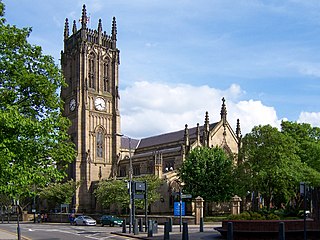
Robert Dennis Chantrell was an English church architect, best-known today for designing Leeds Parish Church, now Leeds Minster.
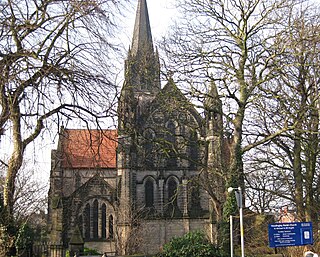
Headingley Parish Church or the Parish Church of St Michael and All Angels in Headingley, a suburb of Leeds, in West Yorkshire, England is a Victorian Church of England parish church. It is a Grade II* listed building.

St Chad's Church, Far Headingley is the parish church of Far Headingley in Leeds, West Yorkshire, England. The church is Grade II* listed in Gothic Revival style. The dedication is to Chad of Mercia, who was bishop of York and died in AD 672. It is set back from the busy Otley Road, with a cricket field and the parish war memorial nearer the road.

George Corson (1829–1910) was a Scottish architect active in Leeds, West Yorkshire, England.

Kelly & Birchall, a partnership between Edward Birchall and John Kelly (1840–1904), was an architectural practice based in Leeds, England, from 1886 to 1904 and specialising in churches in the Italianate and Gothic Revival styles.

The Grade I listed, mainly Norman Church of Saint John the Baptist in Adel, Leeds, West Yorkshire, England has been described by Nicholas Pevsner as 'one of the best and most complete Norman churches in Yorkshire'. It is most notable for its magnificent south doorway with surrounding carvings, and highly carved Norman chancel arch. There is also a replica of a 13th-century sanctuary ring on the exterior of the south door, the original having unfortunately been stolen in 2002. The church is an active Anglican parish church in the archdeaconry of Leeds and the Diocese of Leeds.
Adel and Wharfedale is a ward in the metropolitan borough of the City of Leeds, West Yorkshire, England. It contains 40 listed buildings that are recorded in the National Heritage List for England. Of these, one is listed at Grade I, the highest of the three grades, and the others are at Grade II, the lowest grade. The ward is to the north of the centre of Leeds, and contains the areas of Adel and Cookridge, and countryside to the north. The ward contains St John's Church, which is listed at Grade I, and associated buildings and monuments in the churchyard are listed. Also in the ward is Lawnswood Cemetery, which contains listed buildings and memorials, including a war memorial. In the ward is Cookridge Hall, which is listed together with associated structures. The other listed buildings include houses, farmhouses and farm buildings, two milestones, a public house, and a former reform school.
Carlton, Wharfedale is a civil parish in the metropolitan borough of the City of Leeds, West Yorkshire, England. The parish contains three listed buildings that are recorded in the National Heritage List for England. All the listed buildings are designated at Grade II, the lowest of the three grades, which is applied to "buildings of national importance and special interest". The parish contains the small villages of East Carlton and West Carlton, and is otherwise rural. The listed buildings consist of a hall-house, a farmhouse, and a school later used as a church.
Pool is a civil parish in the metropolitan borough of the City of Leeds, West Yorkshire, England. The parish contains twelve listed buildings that are recorded in the National Heritage List for England. All the listed buildings are designated at Grade II, the lowest of the three grades, which is applied to "buildings of national importance and special interest". The parish contains the Leeds conservation village of Pool-in-Wharfedale and the surrounding countryside. Most of the listed buildings are houses and cottages, and the others include a church, a former toll house, a bridge, three mileposts, and a war memorial.
























